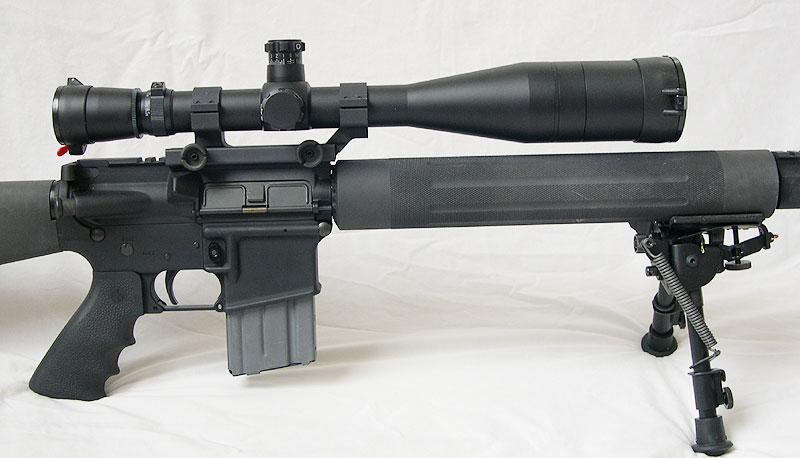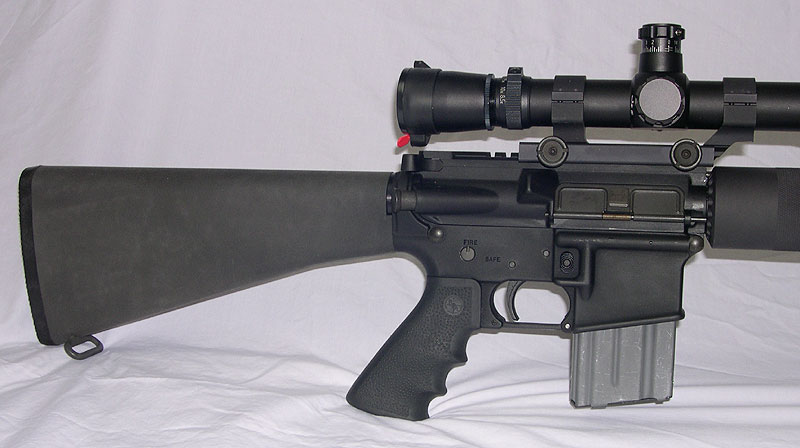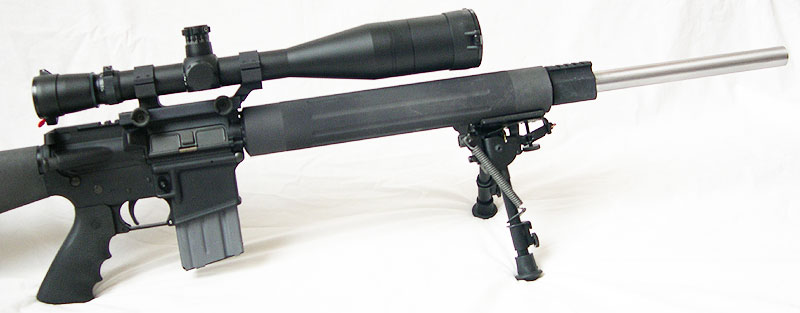 RRA Varmint A4 as we tested it with Armalite Scope Mount(EX0022)
RRA Varmint A4 as we tested it with Armalite Scope Mount(EX0022)
8.7 lbs (4.0 kg) - 18"
9.2 lbs (4.2 kg) - 20"
9.7 lbs (4.4 kg) - 24"
36.25" (921mm) - 18"
38.25" (972mm) - 20"
42.25" (1073mm) - 24"
|
It is not common for us to review .223 rifles, as the caliber is not normally
suitable to long range sniping. Even with the new 80 & 90gr high BC .224 bullets,
there is still inadequate energy on target at long ranges for the caliber to be
effective. But, in certain conditions, like MOUT (urban) environments or in
situations where one is wishing to extend the range of the fire team or squad, a
precision .223 rifle makes a lot of sense and if one's team is familiar with
the M16/M4/AR platform, than a precision AR rifle is the ticket. We were able to
test an off the shelf (thanks goes to John for letting us eval his rifle) Rock River
Arms (RRA) Varmint A4 rifle. The RRA's have had a very good reputation for high
quality products at a good price. So, this rifle is as good as any. There are
several candidates that also would have worked from other manufacturers such as DPMS,
Bushmaster, Armalite and others, but we had to pick one and wanted to see if
RRA's reputation would hold up.
|
|

|
|
|
The RRA rifle we reviewed is their Varmint A4 with a 24" barrel. This rifle was
produced before they started to put the "winter" trigger guard on, so it has
the flat trigger guard. But besides that, this rifle is the way you would get one
if you purchased one from RRA today. The barrel is a Wilson Arms 24" stainless
heavy barrel that is 1.05" thick under the hand guards and .92" from the gas block
to the muzzle. The RRA Varmint rifles come with a Wylde chamber, which is a mix
between .223 and 5.56. For those of you that do not know, the 5.56x45 NATO is NOT
exactly the same as a .223 Rem. The 5.56 spec allows for slightly longer chambers
for higher pressures. The .223 has a tighter chamber around the neck and is shorter
which allows for a bit better accuracy. You can shoot .223 ammo in a 5.56 chamber,
but it is DANGEROUS to shoot 5.56 (surplus for instance) ammo in a .223 chamber.
BE CAREFUL. What the Wylde chamber does is allow for 5.56 ammo with slightly tighter
chamber for better accuracy. So you can shoot both 5.56 and 223 safely with good
accuracy. Now, I may have gotten a little bit of the chamber details a bit off,
but one can search the internet and read about it in detail if you would like.
It is sufficient to say that you can shoot .223 and 5.56 ammo out of the RRA without problem.
|
|

|
|
|
The upper is an A4 flattop upper sporting aluminum free float handguards. There
is nothing special or unique about the upper, bolt carrier group, and other pieces.
But it they are very high quality with a very nice finish.
Everything is tight, smooth, and has a good uniform finish to it. Quality is indeed high.
The lower is a typical AR-15 lower with a fullsize A2 buttstock. The handgrip is a Hogue rubber grip that is a nice touch. It provides a very good grip in all conditions and is comfortable. It fit my hand very nicely. The trigger is something that I would like to mention. The varmint rifle comes standard with the RRA NM two stage competition trigger, and it is VERY nice, it is perhaps the single part on the rifle that that I liked the most. The first stage is very smooth and light and then you feel the resistance of the 2nd stage. There is no take-up on that 2nd stage and it breaks clean at about 4.5 lbs. No, it is not as nice as a jewell or timney that you would find on a bolt action, but for an AR trigger, it is VERY nice. I compared it side by side with a standard DPMS trigger and it as night and day better. Granted, it was a standard DPMS and a NM RRA trigger, not totally a fair comparison, but it did point out how nice it was. |
|

|
|
|
Again, the fit and finish on the lower were very good to excellent. Of course,
the fit between the upper and lower are critical, and was fantastic on this rifle.
There was no play or movement. It was tight and solid. Everything on the overall rifle
showed quality and I am favorably impressed. Of course, the accuracy and shootability
is the ultimate test.
John had already mounted a Leupold Mark4 8.5-25x50mm M1 scope, which as many of you know, is an outstanding piece of glass. Yes, overkill for what I would say is the intended use of the rifle as we see it. But for a relaxing varmint/plinking rifle, it is awesome. The scope is mounted to the rifle using the Armalite scope mount system. For a squad rifle to extend range, a 3.5-10x, 3-9x or 6x would all be good choices. The 24" barrel would also be longer than I would opt for; I'm thinking a 20" would be ideal. But 24" is not out of the question either. The rifle handled nicely and was not too heavy. If part of a mech unit, it is probably a tad long for easy handling in the back of a M2 BFV, but I handled a M24 in the back for years and the rifle survived it, so it could work. Again, 20" may be a bit better for this application. But anyway, off to the range. RRA claims .75 MOA for these rifles, which I think would be good for an out of the box .223 semi auto, but we had heard stories of much better accuracy from these rifles and other .223 AR's. We brought along with us a few different .223 loads including Federal Gold Medal Match 69gr, Hornady Match 75gr BTHP, and some Winchester 62gr white box (cheap ammo). The GMM and Hornady would test ultimate accuracy, while the white box would be a test with cheaper military type ammo. I didn't think at the time to bring some of the 5.56 surplus I have. The first rounds fired was with the Winchester 62gr to clear the bore and check zero (make sure we were on paper!). After two fouler shots were fired, the rifle was settled and ready to go. The Winchester 62gr didn't do too well, but then again, I didn't expect it to. Our average group size was only about 1.3" but we did break the 1 MOA barrier on occasion. 1 MOA with military ammo would be very good for the intended role of this type of rifle and would extend the range of the squad very effectively to about 600 meters on man sized targets. For precision work the ranges would be less, but still, I think it would work very well in this role. It was time to move on to the good ammo. The first group fired with the Hornady 75gr match was right at the RRA claimed .75 MOA, but incidentally, that was the largest group fired with that ammo! Once we saw that the rifle could shoot, we actually really tried, and the groups tightened right up. The best Hornady group was .35" and the average was right at .5" (a tad over). Now that is some excellent accuracy! With a 75gr match bullet, longer ranges are more achievable and more energy is delivered on the target. The gold medal match was even better in terms of accuracy. The small group was .31" and the average was .39". WOW! What a shooter. Here are a few pictures of some of the groups. |
|


|
|
|
As you can see, accuracy is very good with the match ammo, and decent even with
the $4 a box cheap ammo. 1.5 MOA for a hunting rifle is great, and here we are
saying it is only okay!! We have come a long way with tactical rifles. The rifle functioned without a
problem, no jams, no feeding problems, and no problems of any kind. We did not subject
it to severe function testing, so we really cannot comment about ultimate reliability,
but it had no problems with the ammo we shot. I was happy to see there were no
problems with the heavy 75gr bullets in terms of overall length. Of course,
cleaning is never as easy as with a bolt gun, but that is the facts of semi auto life.
|
|

|
|
|
In conclusion, we were very impressed with this rifle, its fit and finish, and
especially its accuracy. Retail price is right around $1000 and I think this is
a deal, especially since you can probably get them for a tad less than that from
a dealer. I personally feel a 20" version with the barrel coated black, the winter
trigger guard, and 6x leupold with SPR reticule would make a great
SPR rifle for the infantry squad. Good job RRA with this rifle and thank you
John for letting us borrow yours.
|
|